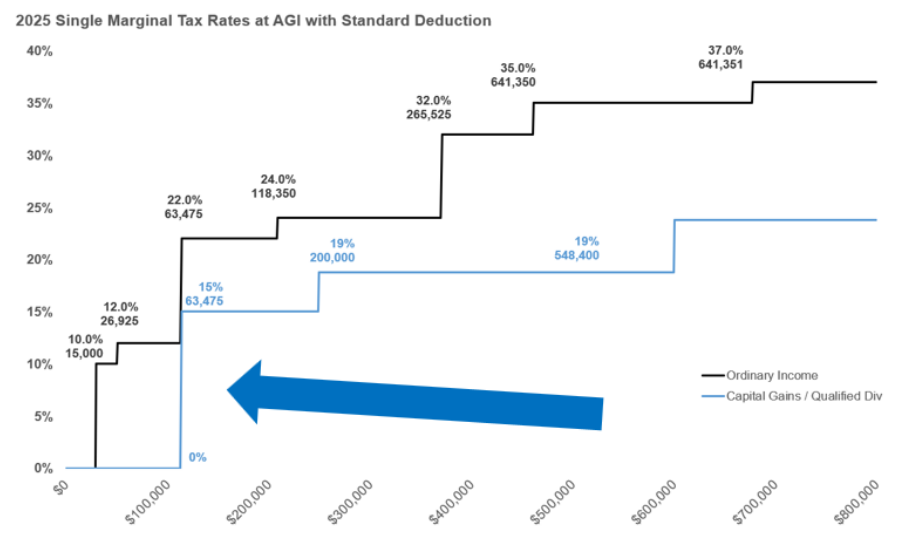It looks like you're new here. If you want to get involved, click one of these buttons!
Very Interesting Article and Video Presentation.Michael Cembalest is the Chairman of Market and Investment Strategy at JP Morgan Asset Management.
Since 2005, Michael has been the author of the Eye on the Market, which covers a wide range of topics across markets, investments, economics, politics, energy, municipal finance and more.
For 2025:
Deregulation, deportations, tariffs, tax cuts, cost cutting, crypto, oil & gas, medical freedom and Agency purges: What could possibly go wrong?
For 2024, individuals with taxable income below $47,025 ($94,050 for married couples) pay 0% tax for long-term capital gains (LTCG). In years when you’re under the threshold you could effectively lock in tax-free long-term gains. The idea would be to realize just enough LTCG to stay within the 0% tax bracket. You also have to tack on the standard deduction which is $15,000 for individuals or $30,000 for a married couple. That means don’t have to pay federal income taxes on your long-term capital gains until your income exceeds a little more than $63,000 (single) or $126,000 (married couple). So you could realize more than $63,000 ($126,000) in capital gains and dividends without paying any federal income tax.


Their 19(a) filing from December@rforno: I can't locate any info on that UTG 60% ROC. Do you have a source?
If you like the sector and the managers take a look at UTES. However if it's the income you were after don't bother. DNP might be an income source.
 https://i.ibb.co/dDw0rm1/Barrons-Cash-Track-011125.png
https://i.ibb.co/dDw0rm1/Barrons-Cash-Track-011125.png https://i.ibb.co/5x4xYCK/MFOP-Quarterly-Top5-010925.png
https://i.ibb.co/5x4xYCK/MFOP-Quarterly-Top5-010925.png  https://i.ibb.co/R69M4pz/MFOP-Quarterly-Bottom5-010925.png
https://i.ibb.co/R69M4pz/MFOP-Quarterly-Bottom5-010925.png There's often a disconnect between Main St. and Wall St.Spectating today, as Mr. Market falls due to GOOD news about jobs.
Divorce between Wall St. and Main St.
BIG swaths of the L.A. basin are going to have to be rebuilt, like N.O. after Katrina. Domestic Marshall Plan will be required. But federal budget is stretched already so far, you can feel it in the 51st State. (LOL.)Sold INCM (not a bad income play). Leaped into RLTY. Gives me 3 equal weight CEFs in the equity / income sleeve, which is something I’d hoped to achieve, It’s a risky bet on rates falling and real estate turning up. Most of my other stuff is pretty conservative, so can play a bit here.
© 2015 Mutual Fund Observer. All rights reserved.
© 2015 Mutual Fund Observer. All rights reserved. Powered by Vanilla